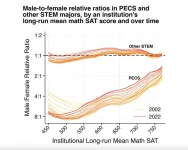(Press-News.org) Highlights:
Researchers from Michigan State University are the first to measure the brain activity of people who had never been to a specific city and then use this brain activity to predict other people’s actual visits to places around that city. This offers potential applications for urban planning and design that addresses the well-being of residents and visitors.
For this study, researchers used principles from the budding field of neurourbanism, which involves measuring the human brain to predict and understand the influence of urban environments on behavior.
The study’s findings suggest that the neural activity in the ventromedial prefrontal cortex — a key region in the brain’s reward system involved in valuation and decision-making — can predict people’s visitation patterns to or away from a specific environment.
EAST LANSING, Mich. – Urbanization, the process by which cities and towns expand in size and population, is rapidly advancing globally, and the percentage of people living in urban environments has increased from 33% in 1960 to 57% in 2023.
Now, researchers from Michigan State University are the first to measure brain activity to make predictions that could help inform enhanced urban planning and design that addresses the well-being of residents and visitors.
Dar Meshi, an associate professor in the Department of Advertising and Public Relations and director of the Social Media and Neuroscience Lab at MSU, led the study, which was recently published in the journal Nature Cities and included collaborators from the University of Lisbon in Portugal. Together, they found that the brain’s reward system can shape human behavior within urban environments and aid in designing cities that promote sustainable living.
Because urban areas typically offer better access to educational and employment opportunities, advanced health care facilities and diverse cultural and recreational activities, they can contribute to a higher standard of living. However, the swift pace of urbanization also gives rise to challenges such as lack of green spaces, increased traffic noise, and social inequities, emphasizing the need for sustainable urban development strategies that prioritize health, safety and well-being for residents.
To better understand how to create proactive urban planning frameworks, Meshi and his co-authors used principles from the budding field of neurourbanism — the study of measuring the human brain to predict and understand the influence of urban environments on behavior — to conduct the study.
“Neurourbanism has the potential to contribute significantly to the design of cities that prioritize cognitive, emotional and physical well-being,” Meshi said. “By prioritizing the well-being of individuals, cities can create environments that are conducive to the overall health and happiness of their inhabitants.”
Neurourbanism employs brain-scanning tools, such as functional magnetic resonance imaging, or fMRI. FMRI detects changes in blood oxygen levels, known as the blood oxygen level dependent, or BOLD, signal, and uses this signal to identify the brain regions that are active during specific tasks or mental processes. When neurons — cells that send and receive signals in your brain — become more active, they require more oxygen. Blood flows to the active areas to meet this demand, and the fMRI detects where changes in blood oxygenation levels occur.
Meshi and his colleagues focused on the ventromedial prefrontal cortex, or vmPFC, a key region in the brain’s reward system involved in valuation and decision-making.
“Previous neuroforecasting research has used activity in the brain’s reward system, including the vmPFC, to predict a variety of population behaviors, such as food choices, music purchasing, crowdfunding outcomes and stock market prices, making it a valuable region to study with respect to urban planning,” said Ardaman Kaur, a postdoctoral researcher in the MSU Institute for Quantitative Health Science and Engineering and one of the study’s authors.
For this study, 77 participants in the U.S. who had never visited Lisbon, Portugal, underwent fMRI scanning while viewing and rating photos depicting urban environments in the city. The photos were geotagged images posted on the photo-sharing application Flickr. The density of photos for each region served as a proxy for measuring visitation patterns around Lisbon.
The findings from the study suggest that the neural activity in the vmPFC can predict people’s visitation patterns to or away from a specific environment.
“People typically make decisions to maximize value, and because certain urban areas induce greater value-related brain activity than others, people in the city are more likely to travel to, or take pictures of, those certain areas,” Meshi said.
According to Meshi, the results of the study imply that the vmPFC may be involved in processing a range of value judgements within urban environments, including perceptual, cognitive, social and cultural values.
“Individuals may be drawn to visit urban spaces not only because of their aesthetic appeal, but also due to their sociocultural relevance,” he said. “This could include places with historical significance or social importance, which may not necessarily be aesthetically pleasing, but still hold considerable value.”
Kaur said this research sheds important light on how our brains may encode information related to urban environments and drive visits around these environments.
“The insights from our study can potentially aid in the development of future human-centric cities, specifically tailored to how our brains perceive and interact with the environment,” Kaur said.
Meshi believes the neurourbanistic approach used in his team’s work can contribute to refining urban planning strategies, ultimately fostering enhanced livability and well-being.
“By incorporating these findings into the urban infrastructure and services, we may be able to create cites that are more efficient and enhance population livability and make it easier for residents to get from place to place,” he said.
###
Michigan State University has been advancing the common good with uncommon will for more than 165 years. One of the world’s leading public research universities, MSU pushes the boundaries of discovery to make a better, safer, healthier world for all while providing life-changing opportunities to a diverse and inclusive academic community through more than 400 programs of study in 17 degree-granting colleges.
For MSU news on the web, go to MSUToday or x.com/MSUnews
END
Smarter city planning: MSU researchers use brain activity to predict visits to urban areas
2024-11-21
ELSE PRESS RELEASES FROM THIS DATE:
Using the world’s fastest exascale computer, ACM Gordon Bell Prize-winning team presents record-breaking algorithm to advance understanding of chemistry and biology
2024-11-21
ACM, the Association for Computing Machinery, named an eight-member team drawn from Australian and American institutions as the winner of the 2024 ACM Gordon Bell Prize for the project, “Breaking the Million-Electron and 1 EFLOP/s Barriers: Biomolecular-Scale Ab Initio Molecular Dynamics Using MP2 Potentials.”
The members of the team are Ryan Stocks, Jorge L. Galvez Vallejo, Fiona C.Y. Yu, Calum Snowdon, Elise Palethorpe (all of Australian National University); Jakub Kurzak (Advanced Micro Devices, Inc.); Dmytro Bykov (Oakridge National ...
Jeffrey Hubbell joins NYU Tandon to lead new university-wide health engineering initiative & expand the school’s bioengineering focus
2024-11-21
Marking a bold step in its transformation into a global research powerhouse, NYU Tandon School of Engineering welcomes Jeffrey Hubbell, a world-renowned chemical engineer and member of four National Academies, to spearhead an ambitious agenda integrating engineering, the sciences, and medicine, to advance healthcare innovation.
As part of this vision, Hubbell will lead a new cross-institutional initiative to translate scientific discoveries into pioneering treatments. A collaboration led out of NYU Tandon and Langone Health, the initiative will include unprecedented investments in new faculty, state-of-the-art new facilities, ...
Fewer than 7% of global hotspots for whale-ship collisions have protection measures in place
2024-11-21
Link to Google Drive folder containing images (caption and credit information below):
https://drive.google.com/drive/folders/1r5eJr78OdIYV0la1pBvRx-ksu9hsNqcw?usp=sharing
Post-embargo link to release:
https://www.washington.edu/news/2024/11/21/whale-ship-collisions/
FROM: James Urton
University of Washington
206-543-2580
jurton@uw.edu
(Note: researcher contact information at the end)
Embargoed by Science
For public release at 2 p.m. U.S. Eastern Standard Time (11 a.m. Pacific Standard Time) ...
Oldies but goodies: Study shows why elderly animals offer crucial scientific insights
2024-11-21
A new study on ageing in the animal kingdom has highlighted how urgently Earth’s oldest and wises creatures must be protected, with knowledge and environmental stability lost due to human intervention.
The new study, led by Charles Darwin University’s (CDU) Research Institute for the Environment and Livelihoods (RIEL), explores the consequences of the loss of old, often large and wise animals in the wild and the value these individuals have to scientific knowledge, biodiversity and more.
Humans are responsible ...
Math-selective US universities reduce gender gap in STEM fields
2024-11-21
Nationally, men in colleges and universities currently outpace women in earning physics, engineering, and computer science (PECS) degrees by an approximate ratio of 4 to 1. To better understand the factors driving these gaps, NYU researchers analyzed bachelor’s degrees awarded in the US from 2002-2022, and found that the most selective universities by math SAT scores have nearly closed the PECS gender gap, while less selective universities have seen it widen dramatically.
“These findings challenge our understanding of gender inequality in STEM education,” says Joseph Cimpian, the study’s lead author and professor of economics and education ...
Researchers identify previously unknown compound in drinking water
2024-11-21
A team of researchers from the United States and Switzerland have reported the discovery of a previously unknown compound in chloraminated drinking water. Inorganic chloramines are commonly used to disinfect drinking water to safeguard public health from diseases like cholera and typhoid fever. It’s estimated that more than 113 million people in the United States alone drink chloraminated water.
The researchers have now identified chloronitramide anion, chemically expressed as Cl–N–NO2−, as an end product of inorganic chloramine decomposition. While its toxicity is not presently known, its prevalence and similarity to other ...
Chloronitramide anion – a newly characterized contaminant prevalent in chloramine treated tap water
2024-11-21
Many public water systems in the United States use inorganic chloramines to disinfect drinking water, but their decomposition products have long been a mystery. In a new study, researchers report the discovery of chloronitramide anion – a compound whose existence, though not identity, has been known for 30 years. Detected in the tap water of millions of Americans, this compound’s toxicity remains untested, prompting calls for immediate toxicological evaluation and raising questions about the safety of chloramine in public water supplies. For over a century, chemical disinfection of public water ...
Population connectivity shapes cultural complexity in chimpanzees
2024-11-21
Cultural complexity in chimpanzees depends on migration and interaction between groups, echoing early human patterns of cultural evolution, researchers report in a new study. The findings offer insight into the development of cumulative culture in early hominins. Culture, defined as a set of socially learned behaviors, has been increasingly documented across various animal species. However, human culture stands out for its complexity and cumulative nature, where cultural knowledge builds upon previous innovations. While chimpanzees – humans’ closest relatives – demonstrate a variety of cultural ...
Direct hearing tests show that minke whales can hear high-frequency sounds
2024-11-21
For the first time, scientists have directly measured the hearing range of minke whales, discovering that the species can detect high-frequency sounds as high as 90 kilohertz (kHz), according to a new study, demonstrating hearing sensitivity far greater than previously believed. The findings suggest that baleen whales – the planet’s largest mammals – may be even more impacted by anthropogenic ocean noise than currently recognized but have been excluded from regulatory consideration due to underestimated hearing ranges. ...
Whale-ship collision risk mapped across Earth’s oceans
2024-11-21
By mapping global ship traffic and whale habitats, researchers found that 92% of whale habitats overlap with shipping routes, illuminating hotspots for whale-ship collision risk, according to a new study. Although only 7% of high-risk areas currently contain management strategies to reduce ship strikes, the findings show that expanding efforts to just 2.6% of the ocean’s surface could significantly reduce these fatal collisions, aiding whale conservation amid booming global shipping. “Mitigating the negative environmental impacts of marine shipping is essential ...



